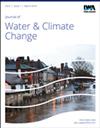富硫酸盐污水滴结构中硫化氢释放的实例研究
IF 3.1
4区 环境科学与生态学
Q2 WATER RESOURCES
引用次数: 0
摘要
H2S是下水道网络释放的主要恶臭气体之一,了解H2S释放到下水道空气空间和通风到大气中的速率对于防止或减少下水道系统中的恶臭和腐蚀问题至关重要。本研究采用TOXCHEM模型模拟H2S气体在道路中的去向。该模型针对春季和夏季进行了校准,并对其余季节进行了验证。经统计分析,预测行为与实际样品的测量结果具有良好的相关性,R2、R和RMSE分别为(0.93-0.97)、(0.8-0.82)和(0.000438-0.000838)。进行了敏感性研究,以评估不同pH值、落差高度、尾水深度、河流宽度和下水道通风水平的影响。结果表明:冬季、春季、夏季和秋季的排放浓度分别为3500、5044、6425和4045 ppm;这个DS的所有排放水平都可以被认为是有害的,这在夏季尤为明显。本研究通过TOXCHEM模型的模拟,帮助阐明了DS硫化氢气体的命运和排放。本文章由计算机程序翻译,如有差异,请以英文原文为准。
Case study of hydrogen sulfide release in the sulfate-rich sewage drop structure
Abstract H2S is one of the principal odor gases released from sewer networks and understanding the rate of H2S release into sewer air space and ventilation to the atmosphere is crucial for preventing or minimizing odor and corrosion issues in sewer systems. TOXCHEM model was used to simulate the fate of H2S gas in roads for this study. The model was calibrated for the spring and summer seasons and validated for the remainder of the seasons. The predicted behavior showed good correlation to measurements on real samples following statistical analysis, with R2, R, and RMSE results between (0.93–0.97), (0.8–0.82), and (0.000438–0.000838), respectively. A sensitivity study was performed to assess the effect of various pH values, drop heights, tailwater depths, stream widths, and sewer ventilation rate levels. The results showed that the emissions concentrations for winter, spring, summer, and autumn reached 3500, 5044, 6425, and 4045 ppm respectively. All the emissions levels from this DS can be considered hazardous, and this was particularly evident during the summer months. This study has helped to clarify the fate and emission of hydrogen sulfide gas at the DS by simulation using a TOXCHEM model.
求助全文
通过发布文献求助,成功后即可免费获取论文全文。
去求助
来源期刊

Journal of Water and Climate Change
WATER RESOURCES-
CiteScore
4.80
自引率
10.70%
发文量
168
审稿时长
>12 weeks
期刊介绍:
Journal of Water and Climate Change publishes refereed research and practitioner papers on all aspects of water science, technology, management and innovation in response to climate change, with emphasis on reduction of energy usage.
 求助内容:
求助内容: 应助结果提醒方式:
应助结果提醒方式:


